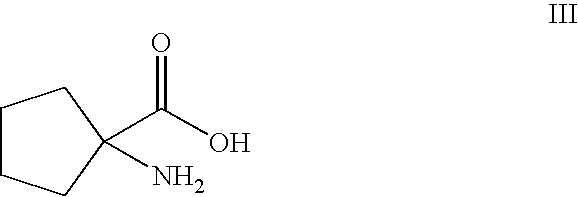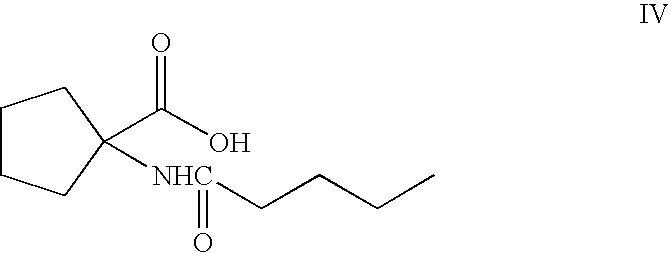Process for preparing irbesartan
a technology of irbesartan and irbesartan, which is applied in the field of preparing irbesartan, can solve the problems of high production cost, excessive production time, and tedious workup procedures, and achieves the effects of less eco-friendly, more expensive and less expensive processes
- Summary
- Abstract
- Description
- Claims
- Application Information
AI Technical Summary
Benefits of technology
Problems solved by technology
Method used
Image
Examples
example 1
[0031]In a process for the preparation of n-pentanoyl cycloleucine of Formula IV, sodium hydroxide (68.2 grams, 1.7 moles) was added to water (275 ml) and cooled the solution cooled to 0-5° C., then there was added slowly a solution of cycloleucine (55 grams, 0.426 moles) and valeryl chloride (77 grams, 0.639 moles) in toluene (55 ml) over about 2-3 hours at 0-10° C. The reaction mass was maintained at 0-10° C. for about 2-3 hours. Water (275 ml) and toluene (55 ml) were added to the reaction mass and the mixture was stirred for about 15 minutes. The aqueous layer was separated and washed with toluene (55 ml), then the aqueous layer pH was adjusted to 2.0-2.5 with 8% aqueous hydrochloric acid (95 ml) and stirred for 15 minutes as a solid formed. The solid was separated by filtration and washed with water (45 ml), then was dried at 70-80° C. to get the desired compound of Formula IV, in an amount of 50 grams.
example 2
[0032]In a process for the preparation of 4-[(alpha-N-pentanoyl amino) cyclopentamido methyl]-2′-cyano biphenyl of Formula VI, a mixture of methylene chloride (750 ml), 4-amino-2′-cyano 1,1′-biphenyl of Formula V (30 grams, 0.144 moles), n-pentanoyl cycloleucine of Formula IV (33 grams, 0.158 moles), hydroxy benzotriazole (3.9 grams, 0.028 moles) and dicyclohexyl carbodiimides (29.7 grams, 0.144 moles) was stirred at 25-35° C., until the reaction was complete. The formed solid was filtered and washed with methylene chloride (30 ml) followed by washing the filtrate with saturated sodium bicarbonate solution (2×250 ml). The organic layer was separated and concentrated under reduced pressure. Cyclohexane (100 ml) was added to the residue and the mixture stirred for 15 minutes. Then the separated solid was removed by filtration, washed with cyclohexane (30 ml), and dried at 70-80° C. to a constant weight to yield the desired compound (59 grams).
example 3
[0033]A process for the preparation of 1-[(2′-Cyanobiphenyl-4-yl) methyl]-2-n-butyl-4-spirocyclopentane-2-imidazolin-5-one of Formula (II) involved charging 4-[(alpha-N-pentanoyl amino) cyclopentamido methyl]-2′-cyano biphenyl (140 ml, 0.347 moles) toluene (1400 ml) and trifluoroacetic acid (40.1 ml) to a vessel, heating to reflux temperature and maintaining until completion of the reaction. After cooling the reaction mass to 25-35° C., the mixture was washed with water (1×400 ml and 1×280 ml) and the organic layer was separated. To the organic layer was added 6% aqueous HCl (1120 ml) and the mixture was stirred for 1-2 hours. The mixture was further cooled to 0-5° C. and stirred for 2 hours. The solid was filtered, washed with toluene (140.0 ml), and dried at 70-80° C. to get the desired compound (88.0 grams).
PUM
 Login to View More
Login to View More Abstract
Description
Claims
Application Information
 Login to View More
Login to View More - R&D
- Intellectual Property
- Life Sciences
- Materials
- Tech Scout
- Unparalleled Data Quality
- Higher Quality Content
- 60% Fewer Hallucinations
Browse by: Latest US Patents, China's latest patents, Technical Efficacy Thesaurus, Application Domain, Technology Topic, Popular Technical Reports.
© 2025 PatSnap. All rights reserved.Legal|Privacy policy|Modern Slavery Act Transparency Statement|Sitemap|About US| Contact US: help@patsnap.com



